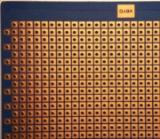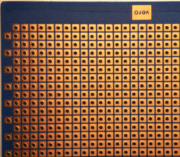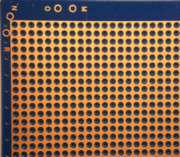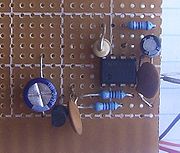
Perfboard
Encyclopedia

Via (electronics)
A via is a vertical electrical connection between different layers of conductors in a physical electronic circuit.- In IC :In integrated circuit design, a via is a small opening in an insulating oxide layer that allows a conductive connection between different layers. A via on an integrated circuit...
). Since each pad is electrically isolated, the builder makes all connections with either wire wrap
Wire wrap
Wire wrap is a technology used to assemble electronics. It is a method to construct circuit boards without having to make a printed circuit board. Wires can be wrapped by hand or by machine, and can be hand-modified afterwards. It was popular for large-scale manufacturing in the 60s and early 70s,...
or miniature point to point wiring techniques. Discrete components are soldered to the prototype board such as resistor
Resistor
A linear resistor is a linear, passive two-terminal electrical component that implements electrical resistance as a circuit element.The current through a resistor is in direct proportion to the voltage across the resistor's terminals. Thus, the ratio of the voltage applied across a resistor's...
s, capacitor
Capacitor
A capacitor is a passive two-terminal electrical component used to store energy in an electric field. The forms of practical capacitors vary widely, but all contain at least two electrical conductors separated by a dielectric ; for example, one common construction consists of metal foils separated...
s, and integrated circuit
Integrated circuit
An integrated circuit or monolithic integrated circuit is an electronic circuit manufactured by the patterned diffusion of trace elements into the surface of a thin substrate of semiconductor material...
s. The substrate is typically made of paper laminated with phenolic resin (such as FR-2) or a fiberglass-reinforced epoxy laminate (FR-4
FR-4
FR-4 is a grade designation assigned to glass-reinforced epoxy laminate sheets, tubes, rods and printed circuit boards . FR-4 is a composite material composed of woven fiberglass cloth with an epoxy resin binder that is flame resistant .FR-4 glass epoxy is a popular and versatile high-pressure...
).
The 0.1" grid system accommodates integrated circuits in DIP packages and many other types of through-hole
Through-hole technology
Through-hole technology, also spelled "thru-hole", refers to the mounting scheme used for electronic components that involves the use of leads on the components that are inserted into holes drilled in printed circuit boards and soldered to pads on the opposite side either by manual assembly by...
components. Perfboard is not designed for prototyping surface mount devices.
Before building a circuit on perfboard, the locations of the components and connections are typically planned in detail on paper or with software tools
Electronic design automation
Electronic design automation is a category of software tools for designing electronic systems such as printed circuit boards and integrated circuits...
. Small scale prototypes, however, are often build ad hoc, using an oversized perfboard.
Software for PCB
Printed circuit board
A printed circuit board, or PCB, is used to mechanically support and electrically connect electronic components using conductive pathways, tracks or signal traces etched from copper sheets laminated onto a non-conductive substrate. It is also referred to as printed wiring board or etched wiring...
layout can often be used to generate perfboard layouts as well. In this case, the designer positions the components so all leads fall on intersections of a 0.1" grid. When routing the connections more than 2 copper layers can be used, as multiple overlaps are not a problem for insulated wires.
Once the layout is finalized, the components are soldered in their designated locations, paying attention to orientation of polarized parts such as electrolytic capacitors, diodes, and integrated circuits. Next, electrical connections are made as called for in the layout.
One school of thought is to make as many connections as possible without adding extra wire. This is done by bending the existing leads on resistors, capacitors, etc. into position, trimming off extra length, and soldering the lead to make the required electrical connection. Another school of thought refuses to bend the excessive leads of components and use them for wiring, on the ground that this makes removing a component later hard or impossible, e.g. when a repair is needed.
If extra wires need to be used, or are used for principle reasons, they are typically routed entirely on the copper side of perfboards. Because, as opposite to strip boards, nearby holes aren't connected, and the only hole in a pad is already occupied by a component's lead. Wires used range from isolated wires, including verowire (enameled copper wire with a polyurethane isolation supposed to melt when soldered)), to bare copper wire, depending on individual preference, and often also on what is currently at hand in the workshop.
For isolated wires thin solid core wire with temperature-resistant insulation such as Kynar or Tefzel is preferred. The wire gauge is typically 24 - 30 AWG
American wire gauge
American wire gauge , also known as the Brown & Sharpe wire gauge, is a standardized wire gauge system used since 1857 predominantly in the United States and Canada for the diameters of round, solid, nonferrous, electrically conducting wire...
. A special stripping tool can be used, incorporating a thin steel blade with a slit that the wire is simply inserted into and then pulled loose, leaving a clean stripped end. This wire was developed initially for circuit assembly by the wire wrap
Wire wrap
Wire wrap is a technology used to assemble electronics. It is a method to construct circuit boards without having to make a printed circuit board. Wires can be wrapped by hand or by machine, and can be hand-modified afterwards. It was popular for large-scale manufacturing in the 60s and early 70s,...
technique but also serves well for miniature point-to-point wiring on perfboard. Bare copper wire is useful when merging a number of connections to form an electrical bus
Electrical bus
Electric bus is a bus powered by electric energy. "Electric bus" can also refer to:* Bus , used for connecting components of a computer or communication between computers* Busbars, thick conductors acting as nodes in electrical substations...
such as the circuit's ground, and when there is enough space to properly route connections, instead of wiring then rats-nest style.
Intentional solder bridges can be used to connect adjacent pads when necessary. Careful hand-eye coordination is needed to avoid causing inadvertent short circuits.
Circuits assembled on perfboard are not necessarily fragile but may be less impact-resistant than printed circuit boards.
Perfboard differs from stripboard
Stripboard
Stripboard is a widely-used type of electronics prototyping board characterized by a 0.1 inch regular grid of holes, with wide parallel strips of copper cladding running in one direction all the way across one side of the board...
in that each pad on perfboard is isolated. Stripboard is made with rows of copper conductors that form default connections, which are broken into isolated segments as required by scraping through the copper. This is similar to the pattern of default connections on a solderless breadboard
Breadboard
A breadboard is a construction base for prototyping of electronics. The term is commonly used to refer to solderless breadboard ....
. However, the absence of default connectivity on perfboard gives the designer more freedom in positioning components and lends itself more readily to software-aided design than stripboard or breadboard.
 |
 |
See also
- StripboardStripboardStripboard is a widely-used type of electronics prototyping board characterized by a 0.1 inch regular grid of holes, with wide parallel strips of copper cladding running in one direction all the way across one side of the board...
(Veroboard) - BreadboardBreadboardA breadboard is a construction base for prototyping of electronics. The term is commonly used to refer to solderless breadboard ....
(Protoboard)

